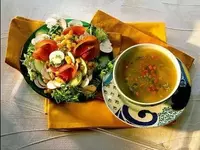The hungarian

Fierce disputes still persist around Hungarian cuisine. For example, the question remains unresolved whether paprika - sweet red pepper - is the original product of Hungarian cuisine. Most researchers are inclined to believe that the paprika spread to Hungary only towards the end of the 19th century, when the Ottoman Empire, on whose territory this plant was in use, had already lost its influence.
Surely, many people associate Hungarian cuisine with a thick meat soup called "goulash. " Hungarian cuisine recipes offer several options for making goulash. One of these, a dish with potatoes cooked in a bowler.
Another traditional dish of Hungarian cuisine is "perkelt. " Its name comes from the Hungarian word, which means "fry" in translation and reflects the way this culinary masterpiece is prepared. Perkelt is made from pre-fried pieces of meat.
There is not much information about the original Hungarian cuisine. The sources contain mainly descriptions of dishes served to aristocratic tables, and for the most part they are of foreign origin. However, Hungarian chefs have always been famous for their skill and if the recipes of Hungarian cuisine were brought from the outside, then the finished look of the dish was acquired here.
If we talk about Hungarian cuisine as a holistic phenomenon, then it should be noted that in this country they invariably preferred soups and dishes, which consist of many ingredients collected in "one pot. " Hungarians are very fond of dressing food with flour and sour cream and quite often add red hot pepper for aroma and taste. Hungarian dishes are prepared mainly on pork fat and certainly contain onions. In Hungary, they eat a lot of onions. In addition to onions, tomatoes and the already mentioned sweet pepper are the favorite vegetables in Hungarian recipes.
It is known that during the Great Migration of Peoples, Hungarians shared the lifestyle of nomads. This has no doubt left its mark on their culture and culinary traditions in particular. For example, this was expressed in the preparation of the so-called "canned food, " which could form the basis for the quick and field preparation of dishes. Such "canned food" includes, first of all, sun-dried dough. In the modern world, this is called "tarhona" - an extremely common semi-finished product in Hungary. nomadic lifestyle was also reflected in the methods of cooking.
Until now, in Hungary, you can find dishes cooked in a rich woman - a small bowler that hangs over an open fire. Hungarian cuisine was very strongly influenced by the already mentioned Turkish cuisine, as well as the cuisines of Italy and France. It cannot be said that because of this, the dishes of Hungarian cuisine have lost their identity and uniqueness. It is worth noting the positive consequences of this impact: the Hungarian culinary tradition has acquired the sophistication and sophistication that was lacking before.
Hungarian cuisine was in a very advantageous position. This is primarily due to a favorable local climate. Almost all the products used in Hungarian cuisine recipes are of local origin.
It is especially worth noting the valuable and even rare fish breeds that are found in the Danube and are actively used in many dishes. This, of course, is a walleye, as well as sterlet, sturgeon and beluga. Most of the river gifts fall into the hands of the cook while still alive, and this alone speaks of the high quality of Hungarian cuisine - an extraordinary, unique and original cuisine.
 Español
Español Français
Français Português
Português Русский
Русский 简体中文
简体中文 繁體中文
繁體中文 日本語
日本語 한국어
한국어 العربية
العربية Türkçe
Türkçe Қазақ
Қазақ Deutsch
Deutsch Italiano
Italiano Українська
Українська
